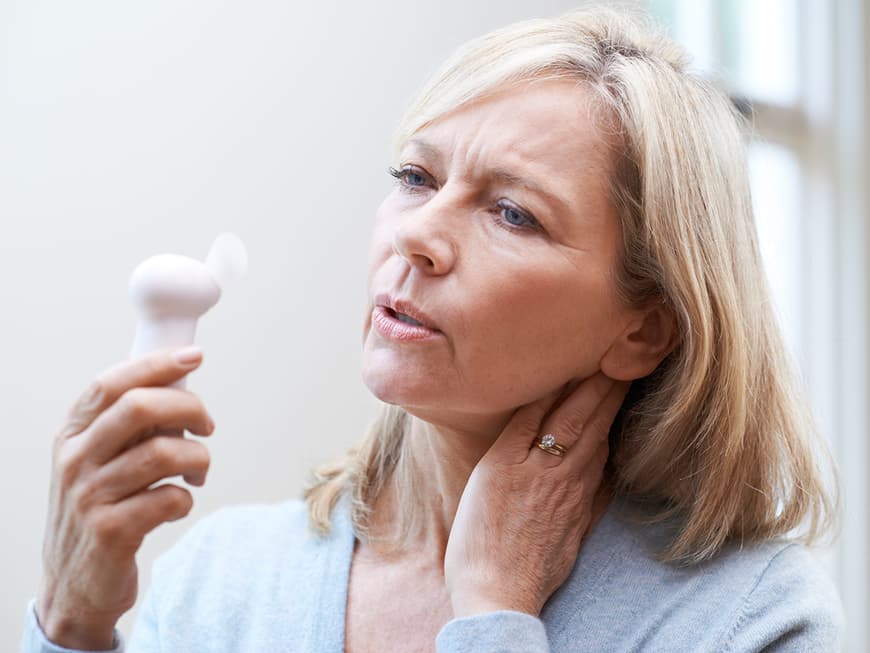
If hot flushes occur during the day or at night, the thought of the menopause quickly comes to mind. For some women, this period of hormonal change passes without any symptoms. For others, however, various symptoms appear and the question arises: What helps against hot flushes?
What do hot flushes feel like?
Hot flushes, which can occur both at night and during the day, belong to the so-called vasomotor complaints, i.e. symptoms that are associated with a narrowing or widening of the blood vessels.1 Those affected initially feel a non-specific discomfort that is accompanied by a feeling of pressure in the head. The hot flushes themselves eventually develop from the center of the body and spread in waves from the chest area to the arms, neck and face. At the same time, spontaneous sweating, palpitations and reddening of the facial skin also occur. This is often followed by a shivering feeling due to the evaporative cold. At night, it is therefore more likely to be the result of the hot flushes that disrupt restful sleep. However, the severity of menopausal symptoms varies from person to person and can also severely affect your well-being in everyday life. It is therefore good for those affected to know what helps against hot flushes and how the quality of life can be improved.
Hot flushes and more: what helps with menopausal symptoms?
When the female body gradually produces fewer hormones, this is a sign of the impending menopause. Symptoms such as hot flushes and sweating restrict the individual's quality of life throughout the day and also at night. In addition, there are complaints such as a reduced sense of pleasure, mood swings (including depressive moods) and a dry mucous membrane in the vagina.2 The severity of the respective symptoms varies from person to person and so the question of how hot flushes feel can only be answered by each woman herself. There is also no single measure or product that helps against hot flushes, so the motto is "try it out". If women experience hot flushes, it is important to know what helps against the symptoms, as they can sometimes severely restrict everyday life. The question also arises as to which illnesses also cause hot flushes.
A healthy lifestyle
Regardless of whether hot flushes occur during the day, at night or not at all: A varied and nutritious food selection, adapted to individual energy requirements, is of great importance for healthy hormonal processes. Plant-based foods, dairy products and oily sea fish play a particularly important role here.
What also helps against hot flushes is sporting activity, as this activates the metabolism as a whole. Sport also helps to maintain muscle mass and improve cardiovascular, bone and mental health.
Anyone who has ever experienced hot flushes may also ask themselves: "What do relaxed, carefree moments feel like?". Stress management methods help to promote relaxation and alleviate anxiety in everyday life. Yoga, progressive muscle relaxation and autogenic training are just a few of the possibilities.3
Alternative methods
If you ask yourself what helps against hot flushes, you will inevitably come across a wide range of alternative methods, such as acupuncture, dietary supplements and other healing methods, most of which have been researched little or not at all. Some studies have shown minor effects, while others have shown unpleasant side effects after prolonged use. Products made from lady's mantle, black cohosh or pomegranate, for example, are said to alleviate hot flushes at night and during the day.3 Overall, however, it is important to question how the hot flushes feel and in what way undesirable effects occur.
Feel and discover what helps against hot flushes
Even the question "How do hot flushes feel?" has a variety of answers, as the sensation varies from person to person. In the same way, what helps against hot flushes varies. At this point, the topic of self-observation is of great importance and those affected should question when hot flushes occur and their intensity. Which methods protect against uncontrolled outbreaks of sweating during the day and help you to get a restful night's sleep. It is also important to know which illnesses also cause hot flushes. Examples include high blood pressure and hyperthyroidism. If in doubt, it is advisable to make an appointment with a general practitioner or gynecologist.
If such illnesses can be ruled out, the menopause may be an option. This is a sensitive time of hormonal change that can lead to symptoms, but for some women it can pass almost unnoticed. If symptoms occur, it is important to clarify the respective causes and finally to take gentle and individually appropriate action.
1 "Menopausal symptoms / menopausal symptoms". Frauenaerzte-im-netz.de, https://www.frauenaerzte-im-netz.de/koerper-sexualitaet/wechseljahre-klimakterium/wechseljahresbeschwerden-klimakterische-beschwerden/. Accessed October 15, 2024.
2 "Menopausal symptoms". gesundheitsinformation.de, https://www.gesundheitsinformation.de/wechseljahrsbeschwerden.html. Accessed October 15, 2024.
3 "Relief of menopausal symptoms". Frauengesundheitsportal.de, October 6, 2021, https://www.frauengesundheitsportal.de/themen/wechseljahre/linderung-von-wechseljahresbeschwerden/. Accessed October 15, 2024.
